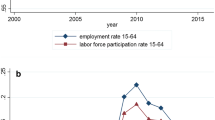Abstract
This paper studies the differential impact of monetary policy on labor market responses for blacks and whites since the start of the Great Recession. We estimate and quantify these differences using a somewhat unconventional approach to identifying an expansionary monetary policy shock. At the long horizon, we find that black employment is more sensitive to changes in monetary policy than that of whites. However, at the short horizon, black employment falls, whereas white employment immediately increases. Owing to such disparities, one might expect the central bank to be deeply engaged in understanding the causal mechanisms at play. Moreover, our findings raise concern that recent monetary policy tightening may adversely affect blacks disproportionately to whites.












Similar content being viewed by others
Notes
For example, Fairlie and Sundstrom (1997), who examine trends in unemployment among black and white men from 1880 to 1990, document the persistence of the unemployment gap and offered up potential explanations.
There is a large empirical literature that studies demographic differences in employment. For example, Shulman (1991) focuses on black-white differences in the unemployment rate. Korenman and Okun (1989) examine gender differences in cyclical unemployment. In related work, Clark and Summers (1981) study cyclical employment fluctuations across race and age.
Hershbein and Kahn (2017) point out that skill requirements on job postings in different metropolitan statistical areas change depending on how hard their labor market was hit by the Great Recession. They also find that these differences are persistent and most pronounced in routine-cognitive occupations.
References
Bernanke B, Blinder A. The federal funds rate and the channels of monetary transmission. Am Econ Rev. 1992;82(4):901–21.
Betsey C. Differences in unemployment experience between blacks and whites. Am Econ Rev. 1978;62(2):192–7.
Bullard J. Shadow Interest Rates and the Stance of U.S. Monetary Policy. Center for Finance and Accounting Research Annual Corporate Finance Conference. Speech from Federal Reserve Bank of St. Louis; 2012.
Carpenter SB, Rodgers WM III. The disparate labor market impacts of monetary policy. J Policy Anal Manage. 2004;23(4):813–30.
Christiano LJ, Eichenbaum M. Identification and the liquidity effect of a monetary policy shock., Political economy, growth and business cycles. London: MIT Press; 1992. p. 335–70.
Christiano LJ, Eichenbaum M, Evans CL. Monetary policy shocks: what have we learned and to what end? Handb Macroecon. 1999;1(A):65–148.
Clark K, Summers L. Demographic differences in cyclical employment variation. J Hum Resour. 1981;16(1):61–79.
Eichenbaum M. Comment on interpreting the macroeconomic time series facts: the effects of monetary policy. Eur Econ Rev. 1992;36(5):1001–11.
Enders W. Applied econometric time series: Wiley; 2008.
Fairlie R, Sundstrom WA. The racial unemployment gap in long-run perspective. Am Econ Rev. 1997;87(2):306–10.
Fry R, Pagan A. Sign restrictions in structural vector autoregressions: a critical review. J Econ Lit. 2011;49(4):938–60.
Fryer RG, Levitt SD. Testing for racial differences in the mental ability of young children. Am Econ Rev. 2013;91(2):145–9.
Heckman JJ, Rubinstein Y. The importance of noncognitive skills: lessons from the GED testing program. Am Econ Rev. 2001;103(2):981–1005.
Hershbein B, Kahn LB. Do recessions accelerate routine-biased technological change? Evidence form Vcancy Postings. NBER Working Paper No. 22762. 2017.
Korenman S, Okun B. Gender differences in cyclical unemployment, Structural Changes in U.S. Labor Markets: causes and consequences: Federal Reserve Bank of Cleveland; 1989.
Krippner L. Measuring the stance of monetary policy in zero lower bound environments. Econ Lett. 2013;118(1):135–8.
Ritter JA, Taylor LJ. Racial disparity in unemployment. Rev Econ Stat. 2011;93(1):30–42.
Shulman S. Why is the black unemployment rate always twice as high as the white unemployment rate., New approaches to economics and social analyses of discrimination. New York: Praeger; 1991.
Sims C. Interpreting the macroeconomic time series facts: the effects of monetary policy. Eur Econ Rev. 1992;36(5):975–1000.
Stock JH, Watson MW. Introduction to econometrics, vol. 467: Addison Wesley Longman; 2003.
Strongin S. The identification of monetary policy disturbances explaining the liquidity puzzle. J Monet Econ. 1995;35(3):463–97.
Thorbecke W. Estimating the effects of disinflationary monetary policy on minorities. J Policy Model. 2001;23:51–66.
Uhlig H. What are the effects of monetary policy on output? Results from an agnostic identification procedure. J Monet Econ. 2005;52(2):381–419.
Ume E. The impact of monetary policy on housing market activity: an assessment using sign restrictions. Econ Model. 2018;68:23–31.
Wu JC, Xia FD. Measuring the macroeconomic impact of monetary policy at the zero lower bound. J Money Credit Bank. 2016;48(2):253–91.
Author information
Authors and Affiliations
Corresponding author
Ethics declarations
Conflict of Interest
The authors declare that they have no conflict of interest.
Appendices
Appendix 1. Forecast Error Variance Decomposition
Appendix 2. Cointegration and Unit Root Tests
There is evidence of cointegration; however, including many variables in a VAR can lead one to believe variables trend together when they really do not (Enders 2008). We decide against an error correction model in favor of the sign restriction model since it will allow us stronger identification.
Contrary to unit root tests results, we do not first difference the variables in the VAR. Instead, variables enter the system in levels, which provides a basis for comparing our results to others in the literature. Moreover, according to Stock and Watson (2003), researchers can rarely be sure whether a series has a stochastic trend or not, due to the low power associated with most unit root tests.
Rights and permissions
About this article
Cite this article
Ume, E.S., Williams, M.J. The Differential Impact of Monetary Policy on Blacks and Whites since the Great Recession. J Econ Race Policy 2, 137–149 (2019). https://doi.org/10.1007/s41996-018-0010-z
Received:
Revised:
Accepted:
Published:
Issue Date:
DOI: https://doi.org/10.1007/s41996-018-0010-z




